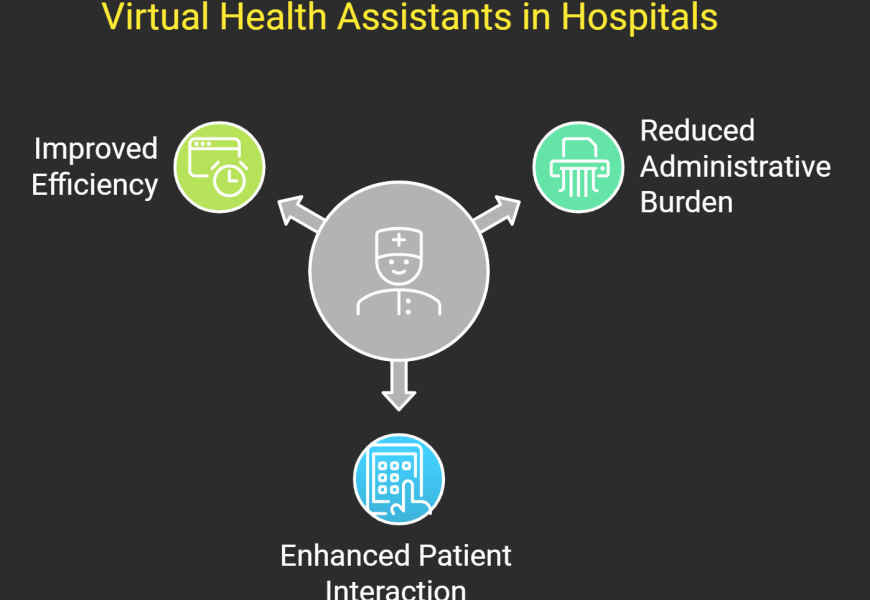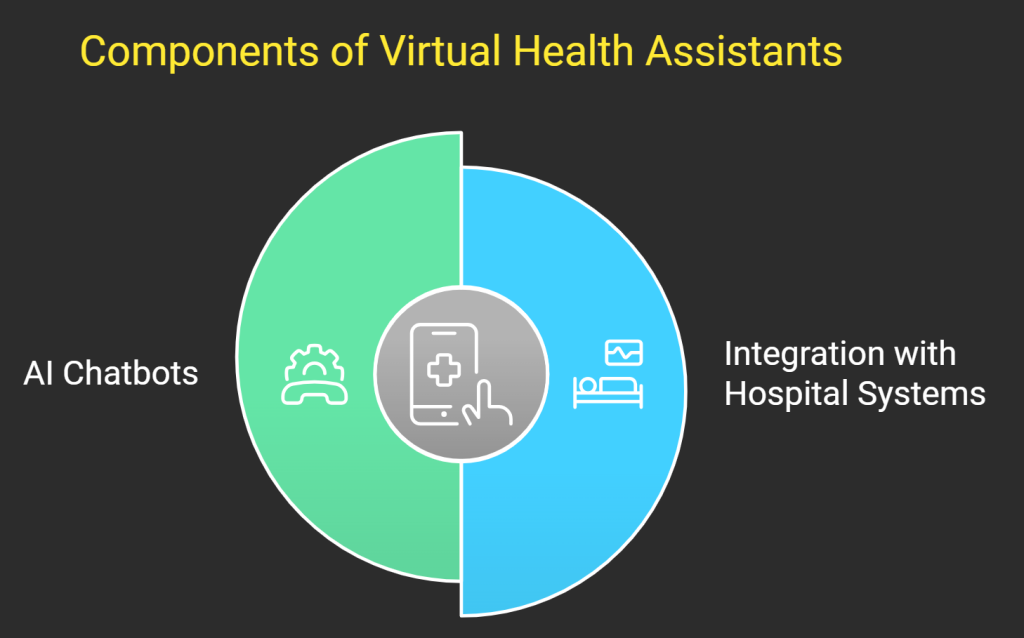Introduction: The Rising Demand for Healthcare Workforce Solutions
Healthcare systems worldwide are under unprecedented pressure due to staff shortages. The World Health Organization predicts a deficit of 10 million healthcare workers globally by 2030. These shortages lead to overburdened staff, increased patient dissatisfaction, and compromised care quality. Hospitals need innovative solutions to address these challenges without compromising efficiency and patient outcomes.
One such solution is the integration of virtual health assistants, an advanced technology designed to optimize operations, streamline workflows, and enhance patient care. This blog will explore how virtual health assistants, combined with hospital management systems and automation in healthcare, can transform the healthcare landscape.
The Role of Virtual Health Assistants in Addressing Staff Shortages
Virtual health assistants are AI-powered tools that reduce the administrative burden on hospital staff. By automating routine tasks, such as appointment scheduling, patient monitoring, and responding to common inquiries, these assistants free up time for healthcare professionals to focus on patient care.
Key Functions of Virtual Health Assistants
- Appointment Scheduling and Management
Virtual health assistants streamline appointment booking processes, ensuring no overlap or errors in scheduling. This reduces the workload for administrative staff and minimizes patient wait times. - 24/7 Patient Support
These assistants offer round-the-clock support by answering patient queries, managing follow-ups, and providing accurate medical guidance through AI chatbots in healthcare. - Remote Monitoring
Virtual health assistants monitor patient vitals and send timely alerts to healthcare providers, improving response times for critical cases. - Documentation Automation
Integrated with a hospital management system, virtual assistants automate record-keeping, reducing errors and ensuring compliance with regulations. - Medication Reminders and Alerts
Virtual health assistants send reminders to patients for medication schedules, improving adherence and overall health outcomes.
Benefits of Virtual Health Assistants for Healthcare Systems
The adoption of virtual health assistants comes with a wide range of benefits, both immediate and long-term. These benefits address the root causes of healthcare staff shortages and improve operational efficiency.
Immediate Benefits
- Reduction in Administrative Tasks
Automation in healthcare eliminates repetitive tasks like data entry, appointment scheduling, and patient follow-ups, allowing staff to focus on critical care areas. - Improved Staff Well-being
By alleviating workload pressure, virtual assistants help prevent burnout among healthcare workers, enhancing job satisfaction and retention. - Enhanced Patient Experience
Patients receive faster and more personalized responses, increasing satisfaction and trust in the healthcare system. - Cost Savings
Virtual health assistants reduce the need for additional administrative staff, leading to significant cost savings for hospitals.
Statistic: According to Accenture, AI-driven virtual assistants could save the healthcare industry $150 billion annually by 2026.
Long-Term Benefits
- Scalable Solutions
Virtual health assistants adapt to increasing patient loads without requiring additional staff, making them ideal for scaling hospital operations. - Error Reduction
Automation in healthcare ensures tasks like data entry and patient monitoring are error-free, improving overall operational accuracy. - Data-Driven Insights
Integrated with hospital management systems, virtual health assistants collect and analyze data, helping healthcare providers make informed decisions. - Sustainable Operations
These assistants ensure hospitals remain efficient and patient-centric, even during periods of high demand.
How Virtual Health Assistants Work
Understanding the functionality of virtual health assistants is essential for their effective implementation in healthcare systems. These AI tools are designed to interact with patients and staff seamlessly, ensuring optimal performance in hospitals.
Integration with Hospital Management Systems
Virtual health assistants connect with existing hospital management systems to streamline operations. For example, they automate data collection and patient record updates, reducing manual workload. This integration ensures smooth communication across departments, enhancing overall efficiency.
Leveraging AI Chatbots in Healthcare
AI chatbots in healthcare play a significant role in the functionality of virtual assistants. These chatbots handle a wide range of tasks, including:
- Providing instant answers to patient queries
- Sending appointment and medication reminders
- Offering symptom-based recommendations for primary care
These chatbots not only reduce administrative burdens but also improve patient engagement and satisfaction.
Automating Critical Healthcare Processes
Automation in healthcare, powered by virtual assistants, transforms processes like patient monitoring, follow-ups, and reporting. For instance:
- Remote monitoring tools alert healthcare providers to changes in patient vitals in real time.
- Automated documentation ensures compliance and accuracy in medical records.
How Virtual Health Assistants Reduce Hospital Staff Workload
The core objective of virtual health assistants is to minimize the workload of hospital staff. Here’s how they achieve this:
- Task Prioritization
By automating routine tasks, virtual health assistants allow staff to focus on high-priority medical care. - Real-Time Assistance
Virtual assistants provide real-time updates and alerts, ensuring critical tasks are addressed promptly. - Efficient Patient Interaction
AI chatbots in healthcare engage patients directly, answering questions and providing guidance, reducing the need for staff involvement. - Seamless Communication
Virtual assistants act as intermediaries, routing queries and information to the right departments, ensuring smooth workflows.
Case Study: A hospital in New York reported a 30% reduction in administrative workload after implementing virtual health assistants. This allowed staff to dedicate more time to patient care, improving outcomes significantly.
Steps to Implement Virtual Health Assistants in Hospitals
Introducing virtual health assistants into a hospital requires careful planning and execution. Here are the key steps:
- Identify Needs and Objectives
Assess areas where virtual assistants can have the most significant impact, such as administrative tasks or patient monitoring. - Choose the Right Technology
Select a platform that aligns with the hospital’s requirements, ensuring compatibility with existing hospital management systems. - Train Staff
Provide training to staff to ensure they understand how to use virtual health assistants effectively. - Integrate with Existing Systems
Seamless integration with hospital management systems ensures optimal performance and data accuracy. - Monitor and Optimize Performance
Regularly evaluate the performance of virtual assistants and make necessary adjustments to improve outcomes.
Real-World Applications of Virtual Health Assistants
Hospitals around the world are leveraging virtual health assistants to address staff shortages and improve patient care. Here are some examples:
- AI Chatbots in Healthcare
Hospitals use AI chatbots to handle patient inquiries, reducing call volumes and freeing up staff for other tasks. - Remote Monitoring Systems
Virtual health assistants equipped with remote monitoring capabilities track patient health and send alerts to providers in case of abnormalities. - Automated Documentation
Integrated with hospital management systems, virtual assistants automate data entry and ensure compliance with medical regulations.
Conclusion: The Future of Healthcare with Virtual Health Assistants
Virtual health assistants represent a transformative solution to one of healthcare’s most pressing challenges staff shortages. By leveraging automation in healthcare, integrating AI chatbots, and streamlining operations through hospital management systems, these tools improve efficiency, reduce workload, and enhance patient care.
As hospitals continue to adopt these technologies, the benefits will extend beyond operational efficiency to create a more patient-centric and sustainable healthcare ecosystem.
FAQs: Virtual Health Assistants in Healthcare
How do virtual health assistants reduce hospital staff workload?
Virtual health assistants automate repetitive tasks such as appointment scheduling, documentation, and patient monitoring. This allows staff to focus on critical patient care, reducing burnout and improving efficiency.
What are the benefits of AI chatbots in healthcare?
AI chatbots provide 24/7 patient support, handle routine inquiries, and improve engagement by offering personalized responses. They significantly reduce administrative workload and enhance patient satisfaction.
How does automation in healthcare improve efficiency?
Automation in healthcare streamlines processes like data entry, patient monitoring, and reporting. It minimizes errors, saves time, and allows healthcare providers to focus on delivering quality care.
Can virtual health assistants integrate with hospital management systems?
Yes, virtual health assistants can seamlessly integrate with hospital management systems to automate workflows, ensure data accuracy, and enhance communication across departments.
What challenges do hospitals face when implementing virtual health assistants?
Challenges include selecting the right technology, ensuring compatibility with existing systems, and training staff to use virtual assistants effectively. However, these challenges can be addressed with proper planning and support.











